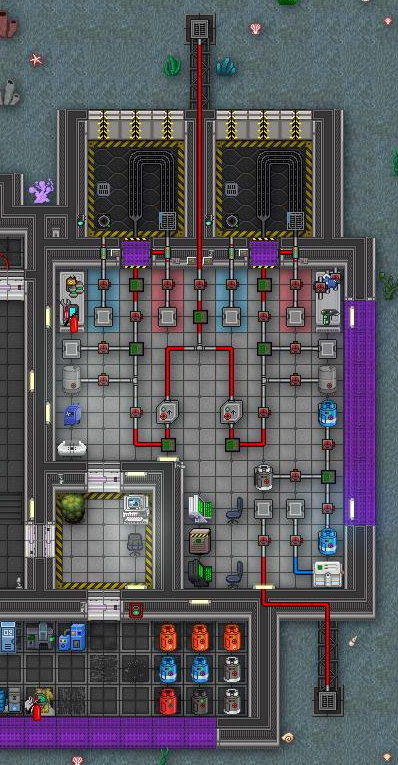User:Studenterhue/Sandbox
Plasma Research (generally known as Toxins) is where scientists intricately study the properties and capabilities of plasma. They do this by superheating plasma and using it to build bombs capable of ripping giant hull breaches into the station and killing everyone. Or, they might just cause an uncontrollable plasma fire in the escape arm or release super-heated carbon dioxide in the hallways, frying people from within. Generally only bad things happen in toxins, which is what makes it such a beloved part of the station.
| Don't test your bombs on the station itself unless you are a legit antagonist. |
|---|
General Practice
To connect a canister to a connector, simply drag it on top of the connector, then wrench it to connect. The gas will automatically start to flow through the pipes. The gas will proceed unless the valve is turned closed (red). The pipes into the combustion chambers are special--some are strictly outtake (gas will only flow towards the mixing room), and some are strictly intake (air will only flow out of the mixing room). More on them later.
To check out the contents of your canisters, use your scientist PDA's built in scanner on it. It will give you a summary of its total pressure, its contents by percentage, and its temperature.
Mixing
The T-shaped section of piping with three ports and valves is for combining the contents of multiple canisters into one homogeneous mix.
Heating
The combustion chambers is/are vacuum sealed room(s) where gas can be piped in, then ignited with a spark by pressing the igniter switch. The resulting hot mixture of gas can be pumped out of the chamber and into empty canisters through the adjacent outlet valves or used to heat whatever gases were feed into the chamber pipes. If the gas is a dud or the experimenting is finished, it can also be vented into space via the Combustion Vent switch.
Cooling
Disposal
Storage & Other
The storage room contains air scrubbers, a tank dispenser, and canisters of various types of gases, most notably, plasma and oxygen.
To test your bombs, use the special simulator equipment (for transfer valve bombs) or alternatively blow up something in the debris field.
How not to die horribly
- Always wear internals.
- Don't open any of the canisters, unless there is a tank attached.
- Do not leave any lit welders around.
- Move any welding fuel tanks out of the lab.
- Don't open a valve if you don't know what it'll do.
- If it looks like gas is leaking, use the air scrubber immediately.
Requirements
- The BYOND client - SS13 is hosted through BYOND, a primitive and admittingly rather sketchy-looking game suite from the 1990s and 2000s. It doesn't matter whether you choose to download of the .exe or the .zip; both give you the same client, compiler, and server software, though the .exe will allow you to join servers via byond:// links on the web.
- Since this is Goonstation, make sure you've the Beta version listed on the Main Page.
- Windows - The BYOND client only runs on Windows, though it is possible to run it on VMWare, WINE, and VirtualBox. This is because...
- Internet Explorer 11+ or Equivalent - BYOND uses Internet Explorer for some of the HTML popups, among other things. Is that stupid? Yes, yes it is. Is it something we just have to deal with for now? Yes, yes it is.
- DirectX 10+/Updated Graphics Drivers - SS13's graphics are far from cutting edge, but in order for lighting and other things to look the way it should, you need updated graphics drivers. Otherwise, it'll look something like this.
Aside from that, there aren't any hardware requirements. For clients, there's no minimum CPU bus speed, ram size, etc.
Connecting to a Server
Which Server Do I Connect to?
Setting Up
Character Preferences
Declaring Ready
Which Job Should I Join As?
Playing
Interaction & Inventory
A Learning Exercise
Chatting
Common Scenarios
Boredom
Hull Breach
Injury
Death
Powering the station: the geothermal capture system
All about Hotspots
These quakes cause particular effects within a certain radius of the center
Hunting for & Centering Hotspots: The Hard Part
For example, if you plop a rod northwest of the your previous spot and get an estimate of 8 when your previous one was 9, you should continue northwest. Conversely, if it's 10, you should head the opposite direction, southeast, and if it's 9 again, you should try another direction entirely.
Overlapping Hotspots
With a bit of intuition and some simple math, you can still decipher where the centers are. If you manage to find a corner of one hotspot where there isn't overlap (that is, readings of 10 and nothing above that), you could intuit the center based on which corner it is (i.e. if you've found the northwest corner of a hotspot, then the center is 10 tiles to the southeast.) From there, since you know where one hotspot is and thus how far you are its center at any point, you can use to decipher the dowsing rod readings. For example, if you get an estimate of 5 and know that there's a hotspot 3 tiles directly north of you, then that means there's another hotspot 2 tiles away in some direction.
Alternatively, you can ignore the distance estimates entirely and rely upon indicator light alone. Theoretically, you could use a single dowsing rod and find the center by the light alone. However, it's usually easier to make a grid of dowsing rods over an area, and





